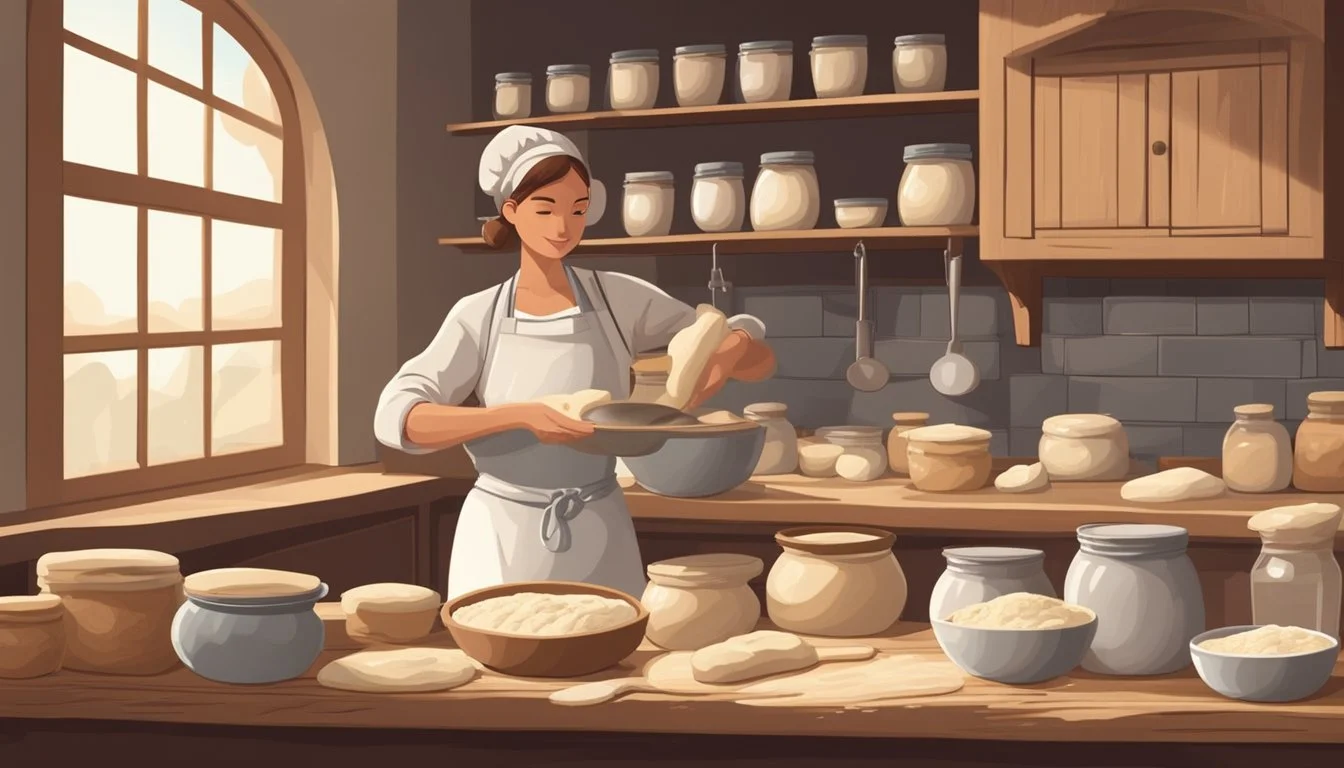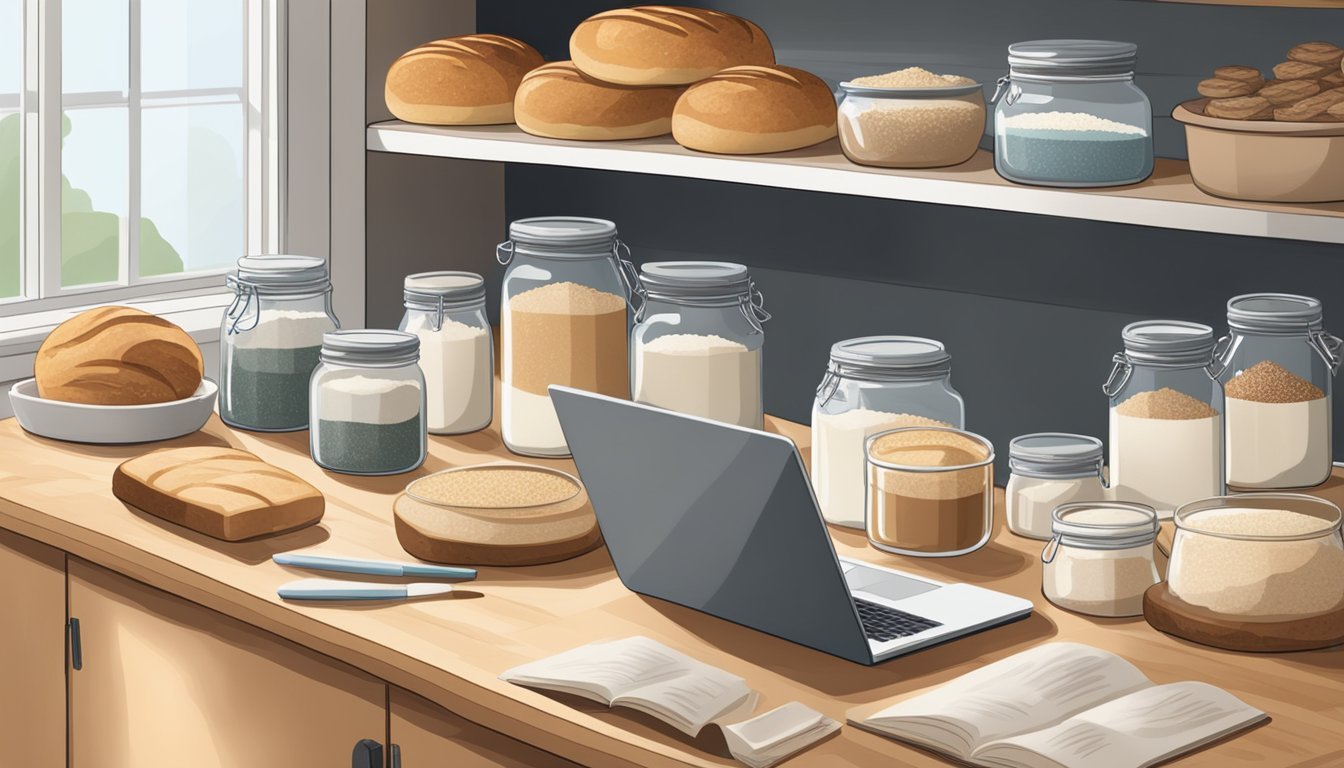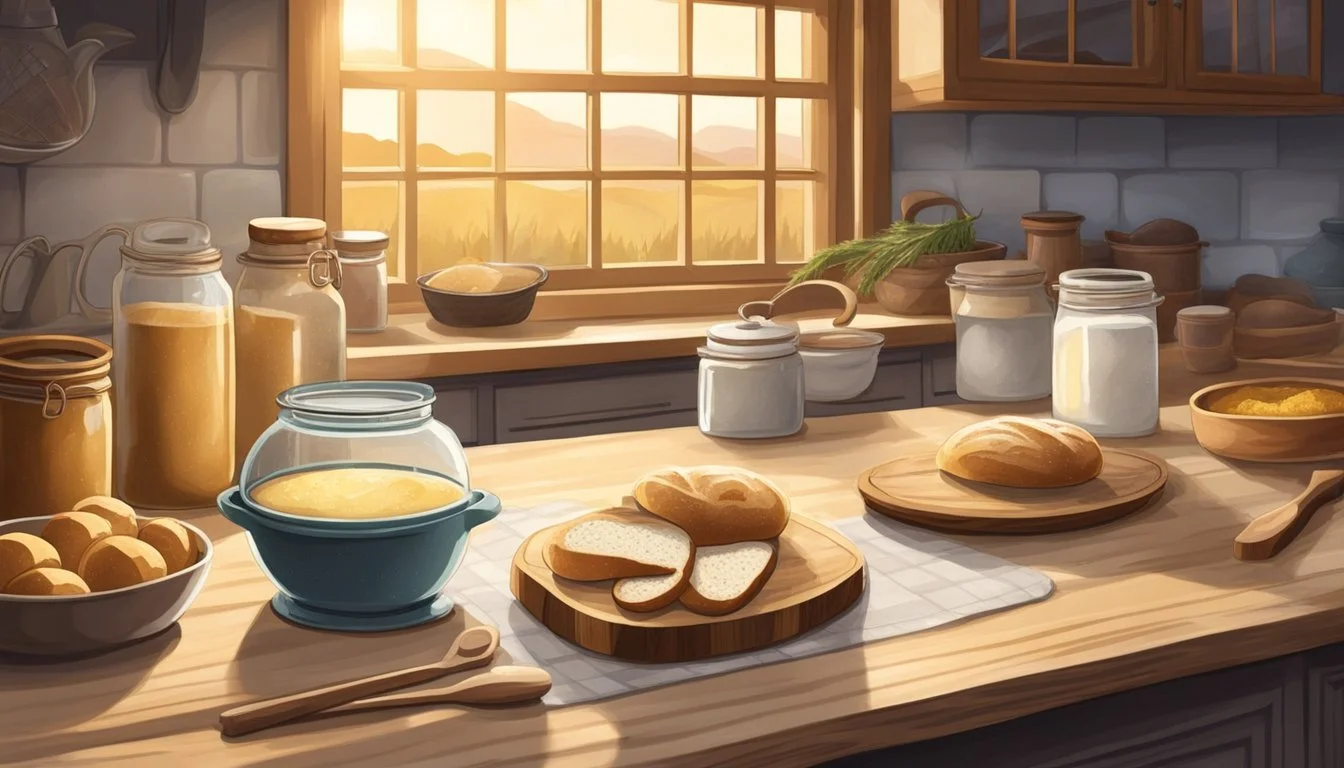Sourdough Baking Classes and Workshops
Master Artisan Bread Making
Sourdough bread (What wine goes well with bread?) baking has captured the interest of hobbyists and culinary enthusiasts worldwide. It's a craft that blends the simplicity of flour, water, and salt with the complex biology of natural fermentation. For many, the allure of sourdough lies in the hands-on experience and the reward of a personal touch in their baked goods. Workshops and classes offer a structured way to learn this ancient technique, allowing bakers at any skill level to plunge into the world of artisanal bread making.
In-person and online sourdough baking courses provide flexibility to learners, catering to the varying schedules and learning preferences of individuals. Platforms such as Udemy boast a community of learners who engage in sourdough bread baking courses that can be started anytime, enhancing accessibility and convenience. For a more tactile experience, bakery-hosted workshops use traditional equipment like wood-fired brick ovens, offering insights into the entire baking process from mixing to final proof.
Advanced classes build upon the basics, diving into the maintenance of different starters and the intricacies of various artisan breads, including pain au levain, whole grain loaves, and traditional rye. These workshops, often including meal options like a pizza lunch, emphasize not just the techniques of baking but also the communal joy that comes with bread-making. Whether one is a beginner or looking to refine their skills, these classes serve as gateways to master the art and science of sourdough baking.
Origins of Sourdough
The history of sourdough bread is ingrained in human civilization and discovery, tracing back thousands of years. Ancient Egypt around 1500 BC is commonly referenced as a starting point for sourdough bread. It’s suggested that wild yeast spores naturally leavened dough left out, leading to the first sourdough loaves.
Following this inadvertent discovery, the technique of sourdough baking blossomed. By 800 BC, the Ancient Greeks and later the Roman Empire took on sourdough processes, enhancing the craft of artisan bread baking.
A sourdough starter—essential for baking sourdough—is a mixture of flour and water that captures wild yeast from the environment. This simple, yet elegant solution allowed bakers to create bread with a unique flavor profile and texture.
Transitioning through the ages, sourdough maintained its popularity even amidst the rise of commercial yeast in the 19th century. Its unique flavor and the artisanal skill required to bake it meant sourdough continued to be cherished as more than just sustenance—it became a valued tradition connecting generations.
Throughout modern history, sourdough has gained recognition not only for its taste but also for its perceived health benefits over breads made with commercial yeast. This contribution to both health and heritage ensures that sourdough retains its special place in the art of baking.
Fundamentals of Sourdough Making
Mastering the fundamentals of sourdough making can elevate one's baking skills from novice to artisan. This section aims to demystify the initial steps of creating sourdough bread through understanding the starter, familiarizing oneself with the sourdough process, and recognizing the key ingredients involved.
Understanding Your Starter
A sourdough starter is a live culture of flour and water. Once it begins to ferment, the starter becomes a breeding ground for wild yeast and bacteria, which will be responsible for the rising of the dough. Maintaining a starter involves regular feeding with equal parts flour and water to keep it active and healthy. The right balance of hydration, temperature, and feeding can lead to a robust starter, essential for flavorful and well-leavened bread.
The Sourdough Process
The sourdough process is a testament to patience and technique. Following a recipe carefully, one combines the starter with more flour and water to create a dough. This dough undergoes several stages:
Mixing: Incorporating the starter with new flour and water.
Autolyse: Allowing the dough to rest, which facilitates gluten development without additional kneading.
Bulk Fermentation: A period during which the dough is left to rise, developing flavor and structure.
Shaping: Forming the dough into loaves.
Proofing: A final rise before baking.
Baking: Applying heat, which causes the dough to expand and the crust to form.
Every stage is crucial, with timing and ambient conditions playing pivotal roles in the outcome of the bread.
Key Ingredients for Sourdough Bread
Sourdough bread, in its simplest form, is based on four essential ingredients:
Flour: The backbone of the dough, providing structure and nutrients for the yeast.
Water: Hydrates the flour, aids gluten formation, and determines the dough’s consistency.
Salt: Enhances the flavor and regulates yeast activity.
Sourdough Starter: Introduces natural yeast and bacteria, enabling the dough to rise.
The quality and ratio of these ingredients will influence the texture, taste, and crumb of the sourdough bread. Variations in flour types and hydration levels can also yield diverse results, from dense ryes to airy ciabattas.
Equipment and Tools
In the artisanal world of sourdough baking, having the right tools is crucial for both beginners and experienced bakers. The key to producing high-quality sourdough bread lies in the precision and reliability that specific equipment brings to the kitchen.
Essential Sourdough Tools
A sourdough starter is the foundation of sourdough baking, marking the departure from traditional yeast-leavened bread. To manage and maintain a starter, certain items are non-negotiable:
Digital Scale: Precision in measurement is vital, as sourdough bread recipes require exact proportions for consistency.
Dough Scraper: A dough scraper helps in handling and shaping the dough with ease.
Proofing Basket (Banneton): Gives the dough structure and shape during the final rise.
Cast Iron Dutch Oven: Mimics a professional baker’s oven, trapping steam and heat for a well-developed crust.
Lame (Dough Scorer): A lame or sharp knife is used to score the dough, allowing it to expand properly during baking.
Advanced Baking Equipment
For those who have mastered basic sourdough baking and are delving into more intricate artisan baking techniques, additional equipment can further enhance their craft:
Grain Mill: For bakers who prefer to work with freshly milled grains, a home grain mill is a valuable addition to the kitchen.
Bread Proofing Box: Offers a controlled environment for the dough to rise, which can be particularly useful in cooler climates or for consistency in proofing times.
Challenger Bread Pan: Noted for its heavy cast-iron base and lid, this pan is an excellent tool for achieving superior oven spring and crust development.
Stand Mixer with Dough Hook: While not essential, it can significantly reduce the physical effort required in kneading wet, sticky sourdough doughs.
By investing in these essential and advanced tools, artisans can ensure consistent, high-quality sourdough bread and refine their baking techniques to professional standards.
Sourdough Baking Workshops
Sourdough baking workshops are offered in various formats to cater to enthusiasts' preferences and schedules. These workshops range from in-person classes that provide hands-on experience to digital courses for remote learning, as well as private and group sessions tailored to individual or collective needs.
In-person Workshops
In-person sourdough baking classes offer a comprehensive learning experience, including tactile techniques such as shaping and scoring bread. For instance, Muddy Fork holds workshops in their bakery featuring their wood-fired brick oven and includes a pizza lunch, with a cap of 10 participants per session at $95 each. Participants are involved in the entire bread-making process from start to finish. Heather's Hearth offers a similar experience where attendees receive additional resources like a sourdough bread baking ebook and enjoy provided lunch and refreshments.
Digital Courses
For those who prefer learning from the comfort of their homes, digital sourdough baking courses are available. These digital courses, accessible via platforms such as Zoom, include step-by-step video instructions. Chillspice Sourdough Workshops provides videos on artisan and sandwich sourdough, highlighting their no-knead, minimal hands-on time methods that can be followed by an overnight rise. This allows learners to master sourdough baking at a pace and time that suits them without sacrificing the quality and depth of the knowledge imparted.
Private and Group Classes
Private and group classes offer personalized attention for those seeking a more custom learning experience. Whether it's through an online format or in a setting like Vituperio Baking Studio, these classes cater to specific needs, ranging from choosing dates for in-person baking to arranging group sessions for a more intimate learning environment. Here, participants can even find opportunities to purchase sourdough bread baked for local farmers' markets, providing a taste of professionally crafted artisan sourdough.
Improving Your Technique
Mastering sourdough baking is a blend of art and science. The reader will learn precise techniques to ensure their dough is manipulated correctly for beautiful loaves and consistent results.
Shaping and Scoring Dough
When shaping dough, bakers should aim for a tight but not overworked form, setting the stage for an aesthetically pleasing and delicious loaf. The tension on the surface of the loaf facilitates proper expansion in the oven. One can use bannetons for a distinct spiral pattern or simply shape it into a boule on a flat surface for a rustic look.
Scoring dough is crucial; it's not just decorative but functional. It directs the way bread expands during baking. A lame or sharp blade is essential for making clean cuts. An angled incision will create an "ear" when the dough rises, contributing to the artisanal allure of the sourdough.
Achieving Consistent Results
Consistency is the hallmark of experienced bakers. To achieve consistent results:
Measure Ingredients Precisely: Use a digital scale for flour, water, starter, and salt.
Temperature Control: Maintain a consistent dough temperature between 75-78°F (24-26°C).
Record Keeping: Maintain a baking log that tracks metrics such as ambient temperature, humidity, proofing time, and baking results. This can guide adjustments in future bakes.
Analyzing each bake and making incremental changes leads to improved outcomes. Repetition and careful notetaking allow bakers to understand how variables interact and affect the sourdough.
Sourdough Recipes and Variations
Sourdough baking has gained esteemed status among artisan bread enthusiasts due to its complex flavor profiles and natural fermentation process. Beginners may start with a basic sourdough loaf, which is a versatile foundation for various recipes. The incorporation of rye flour, for instance, introduces a deeper flavor and a denser texture to sourdough bread.
One popular variation is the Sourdough Rye Bread, which employs a blend of rye flour and a small amount of ripe sourdough starter. This combination is usually left to develop overnight, enhancing the sourness characteristic of artisan bread.
For those with a sweet tooth, specialized classes offer instruction on integrating sourdough into sweetdough recipes. Examples include:
Brioche: A rich, pillowy bread ideal for breakfast or dessert.
Panettone: A festive, fruit-studded loaf traditionally enjoyed during holiday seasons.
Stollen: A German bread packed with dried fruit and marzipan.
Sweetdough Variations Description Brioche Buttery, light, and slightly sweet. Panettone Tall, fruity, and often served at Christmas. Stollen Dense with dried fruits and dusted with sugar.
Expert courses might delve into more advanced artisan variations, instructing participants in the use of different starters and fermentation techniques to achieve distinctive textures and tastes. These include but are not limited to:
Pain au Levain: Traditional French sourdough.
Traditional Rye Breads: Dark, dense, and typically pairing well with strong cheeses.
In sandwich making, the versatility of sourdough shines through. The classic sourdough loaf can be transformed into the perfect sandwich bread with a chewy texture and robust flavor, capable of complimenting various fillings from cold cuts to gourmet cheeses and preserves. It underscores how sourdough's adaptability extends from simple loaves to intricate, celebratory breads.
Community and Support
Participating in sourdough baking classes often includes the added benefit of joining a robust community. Members can find mentorship, encouragement, and continuous learning through regular interactions with fellow enthusiasts.
Joining a Sourdough Community
When an individual enrolls in a sourdough baking class, they gain membership to a unique group of passionate bakers. The key advantages are:
Supportive Environment: The community provides a space for members to share successes, address challenges, and exchange tips.
Networking Opportunities: Members can connect with peers and professionals, offering a rich source of inspiration and collaboration.
Classes provide more than just lessons; they offer an entry into a continuous sourdough adventure where bakers of all skill levels can grow together.
Social Media Groups
The rise of social media has facilitated the formation of dedicated sourdough groups. Here are common platforms:
Facebook Groups: General or private Facebook groups cater to sourdough enthusiasts offering a mix of knowledge-sharing and personal experience.
Platform Group Characteristics Facebook Diverse membership, easy sharing, regular updates Private Groups Curated content, in-depth discussions, enhanced privacy
Community Engagement: Individuals share recipes, troubleshoot baking issues, showcase their bakes, and participate in challenges or polls.
These groups act as a hub for sourdough bakers to connect, learn, and celebrate the art of sourdough bread together.
Health Benefits of Sourdough
Sourdough bread stands out when it comes to nutritional value and health benefits. They often choose it for its nourishing properties and the presence of beneficial bacteria due to the fermentation process.
Digestibility: The fermentation process breaks down gluten, which can make sourdough bread easier to digest than its non-fermented counterparts. People with mild sensitivities to gluten may find sourdough bread to be a more comfortable option.
Lower Glycemic Index: The lactic acid produced during sourdough fermentation can reduce the bread's glycemic index, leading to a slower rise in blood sugar levels.
Nourishment: Sourdough bread is typically made with simple, wholesome ingredients that can contribute to a balanced diet.
Nutrient Benefit Fiber Promotes digestive health Prebiotics Nourishes good gut bacteria Vitamins Such as B1, B6, B12, folate, and E Minerals Including iron, selenium, and magnesium
It's notable that sourdough's natural fermentation also increases the availability of these nutrients, enhancing the body’s ability to absorb them.
Natural Preservation: The acidity of sourdough bread acts as a natural preservative, meaning it can have a longer shelf-life without the addition of chemical preservatives.
Choosing sourdough is not only a taste preference but also a decision toward a more health-conscious lifestyle. It incorporates beneficial bacteria and enzymes, contributing to overall well-being.
Additional Resources
In the journey of mastering sourdough bread baking, enthusiasts often seek additional materials to supplement their learning. These resources can provide clarity on terminology, answer common questions, and offer insights through shared experiences.
Sourdough Glossary
A Sourdough Glossary is an essential tool for beginners and seasoned bakers alike, elucidating the specific lingo used in the world of sourdough. Terms such as autolyse, levain, and hydration can be confusing at first. One should refer to a comprehensive glossary to better understand the intricate details of sourdough bread recipes and methods.
Frequently Asked Questions
The Frequently Asked Questions (FAQ) section serves as a quick reference to address common concerns that arise during the sourdough baking process. From troubleshooting a starter that won't rise to achieving the perfect crust, an FAQ collects and answers those pressing questions bakers encounter, saving time and easing the learning curve.
Sourdough Blogging
For those seeking an ongoing source of information, Sourdough Blogging can be a treasure trove of tips, tricks, and personal experiences. Bloggers often document their baking journeys, offering valuable insights on everything from maintaining a healthy starter to experimenting with different types of flour. Readers can benefit from the trials and successes of others, as they passionately share their sourdough stories.
Starting Your Sourdough Business
Starting a sourdough business can be a fulfilling endeavor. Key considerations involve setting up a physical shop and establishing a robust online presence to attract and maintain a customer base.
Opening a Sourdough Shop
When opening a sourdough shop, location is paramount. It should be accessible and visible to ensure steady foot traffic. The shop's aesthetics can contribute significantly to the customer experience, encapsulating the warmth and joy of sourdough baking.
Essential Equipment:
Ovens: Reliable, commercial-grade ovens with accurate temperature controls.
Mixers: Heavy-duty mixers that can handle large batches of dough.
Proofing Baskets: Baskets that give sourdough its shape and assist with proofing.
Scales: Accurate digital scales for precise ingredient measurements.
The shop should clearly display contact information and business hours, making it easy for customers to reach out. Potential bakers might also be interested in workshops, so this information should be readily available.
Online Presence and Marketing
An online presence is crucial for a sourdough business. The website should be user-friendly and reflective of the shop’s ethos, with sections detailing the story (about the business), the variety of sourdough products offered, and how customers can contact the shop or sign up for workshops.
Marketing Strategies:
Social Media: Platforms like Instagram and Facebook to showcase products and share behind-the-scenes glimpses.
SEO: Search engine optimization to improve the website's visibility in search results.
Email Marketing: To keep customers informed about new products, workshops, and promotions.
By focusing on these key aspects, a sourdough business can create a strong foundation and a loyal customer base that delights in the unique joy of sourdough bread.
Storing and Sharing Your Sourdough
When attending sourdough classes, one of the key skills participants will learn is the proper storage of sourdough starter—the foundation of every sourdough loaf. In its basic form, a starter requires regular feeding with flour and water to maintain its vitality. For ease of long-term storage, a starter can be dehydrated. This process involves spreading the active starter thinly and allowing it to dry completely. Once dry, the starter flakes or powder can be stored in an airtight container at room temperature, away from direct sunlight and moisture.
Here's a brief guide to storing a dehydrated sourdough starter:
Condition Action Short-term: Store in a cool, dry place away from sunlight Long-term: Keep in the refrigerator or freeze for extended periods Reactivation: Soak in water and feed with flour to reactivate
Sharing sourdough starter is a cherished tradition in the baking community. A starter can be divided and shared with friends, family, or fellow baking enthusiasts. Many bakers enjoy gifting a portion of their starter as a symbol of friendship and community, often accompanied by instructions on how to care for it. When sharing, it's beneficial to include tips on revival and maintenance, especially if providing dehydrated starters, which may require specific rehydration steps.
Quality sourdough classes often emphasize the importance of starters and will guide beginners through the process of creating, storing, and sharing them. This ensures that the art of sourdough baking isn't just about creating delicious bread but also about nurturing and distributing a piece of baking heritage.
Join the Artisan Sourdough Movement
The artisan sourdough movement celebrates the time-honored tradition of bread making, melding technique, and creativity. Enthusiasts are growing a community bound by the love for beautiful, handcrafted bread.
Classes and Workshops
Introductory Classes: They open the door to basic sourdough baking, covering essential techniques, terminology, and starter maintenance.
Advanced Workshops: For those looking to enhance their skills, topics might include crafting brioche, panettone, and other sophisticated bread.
Online Courses: Flexible options are provided for at-home learning, with resources ranging from recorded video instruction to downloadable PDF recipes.
By participating in these educational experiences, bakers learn to appreciate the craftsmanship involved in creating artisan bread. Each workshop empowers individuals with knowledge to experiment and integrate sourdough baking into their daily routines.
Key Aspects of Sourdough Baking
Starter Preparation: The cornerstone of sourdough, instructors teach methods to nurture a healthy, active starter.
Dough Handling: Emphasizing techniques like shaping and scoring for aesthetic and practical purposes.
Baking Schedules: Adaptable baking schedules are covered to accommodate the busy lifestyles of aspiring bakers.
Joining a sourdough class or workshop not only hones a person's baking skills but also immerses them in a community which values sustainability, shares insights, and celebrates the achievement of creating beautiful loaves of bread. It is an opportunity to partake in a movement that is as delicious as it is fulfilling.
Final Thoughts
Sourdough baking classes and workshops offer an opportunity for enthusiasts to deepen their understanding and refine their skills. Participants experience the satisfaction of creating bread from scratch, which can bring a sense of joy and accomplishment. These educational sessions are not just about following recipes; they encapsulate the science and art behind sourdough baking.
Key Takeaways:
Knowledge Reinforcement: Classes provide detailed insights into the intricacies of sourdough, from maintaining a starter to understanding fermentation.
Skill Development: Hands-on experience helps solidify baking techniques, such as scoring, shaping, and timing.
Important Considerations:
Preparation: It's vital for attendees to come prepared, perhaps making a sponge prior to class for a more enriching experience.
Community: Workshops often foster a sense of community, allowing bakers to share experiences and tips.
Workshop Options May Include:
Virtual and in-person sessions
Starter maintenance and creation
Exploring different flours and hydration levels
Creating diverse bread types like cinnamon swirl or focaccia
Most workshops welcome bakers of various skill levels, although some may require basic knowledge. These sessions not only aim to teach but also to inspire a lifelong passion for sourdough baking. Enthusiasts are encouraged to explore these classes to not only enhance their baking repertoire but also to join a community that values the craft of traditional bread-making.








